Uplift Review: Vacation on Layaway

Taking a vacation is necessary to recharge your emotional and mental batteries, but according to the U.S. Travel Association, more than half of Americans leave vacation time on the table each year, which in 2015 amounted to 658 million unused vacation days.
Budget is obviously a big reason people postpone their vacations. The average American dream vacation takes almost an entire year to save for. Unless you use Uplift that is.
What Is Uplift?
Uplift lets you take out loans to use for travel, and that means you can pay off the cost of your vacation over time instead of all at once up front. Uplift partners with major travel providers, so the actual process of applying for your loan is simple and quick.
When you’re booking a trip, just select the Uplift “Pay Monthly” option as your payment method and you’ll be directed to fill out a simple application. Most major airlines have begun to offer this option, so it’s not like you’ll need to fly an obscure brand either.
Within seconds you’ll get a decision on your loan and be one step closer to your dream vacation. From there, you’ll make fixed monthly payments for a set amount of time, just like any other loan.
For example, Uplift prices a weekend trip to Vegas at $707, which sounds a lot more manageable when broken down into 12 monthly payments of $63.
Why Should I Use Uplift for My Vacation?
By paying for a vacation monthly instead of upfront, traveling instantly becomes more affordable for a lot of people. Uplift isn’t necessarily making your vacation cheaper, but it’s making the overall cost much easier to handle.
You can take your trip before your loan is paid off and enjoy a personal weekend getaway or a family vacation without stress.
Uplift also allows you to stretch your budget further and get more out of your vacation. When you’re not constrained to upfront costs, maybe you’ll splurge on food, drinks, or a nicer hotel to really make your vacation memorable.
As long as you don’t overspend, Uplift is a perfect way to plan — and pay for — your dream vacation.
What Are the Risks?
As with any loan, you take on some level of risk when you borrow money. Borrowing money to go on vacation isn’t considered “good debt,” but if you stay within your means, a vacation on layaway will ease stress and make work more enjoyable.
Paying off a loan on time can help build your credit score, but if you fall behind on your payments, your credit rating will suffer. The tried and true method of saving up for a vacation will always be safer than taking out a loan.
Your loan will also come with interest, meaning you’ll end up spending more than you would have by booking a vacation traditionally. For instance, the Las Vegas example above costs about $60 more through an Uplift loan. Overall that only amounts to $5 per month.
The added interest won’t break the bank, but it’s something to note any time you take out loans.
Learn more about debt: Good Debt, Bad Debt, and How to Tell the Difference.
Is Uplift Worth It?
It can be pretty tempting to dive right into using something like Uplift. The promise of a dream vacation is almost too good to pass on.
Still, you don’t want to end up stretching yourself too thin financially. Uplift shouldn’t be a way for you to plan a vacation you could have never imagined paying for; it can help you get a few steps closer to a trip that’s always been a little out of reach.
Be aware of the APR on your loan and understand how much extra you’ll pay in interest. It’s a good idea to compare the cost of using your credit card to pay for the trip. If the interest rate lower on your card and you have the credit, you’ll save money that way.
On the other hand, Uplift ensures your travel loan is separate and easy to keep track of.
In the end, your decision to use Uplift or not should boil down to your personal financial situation. If you use Uplift and don’t have trouble making your payments, you’ll be able to enjoy some much-needed vacation time.









